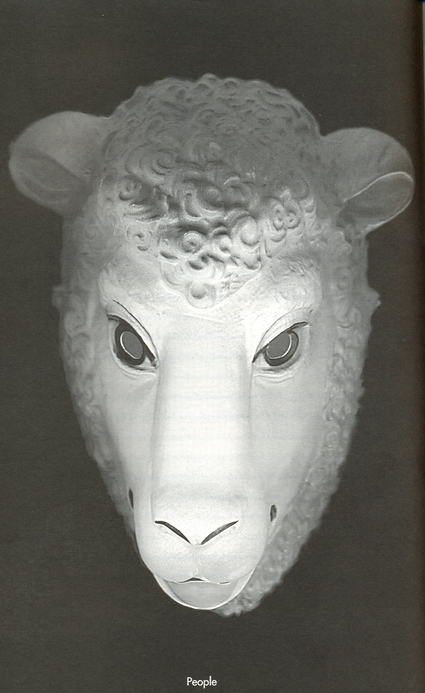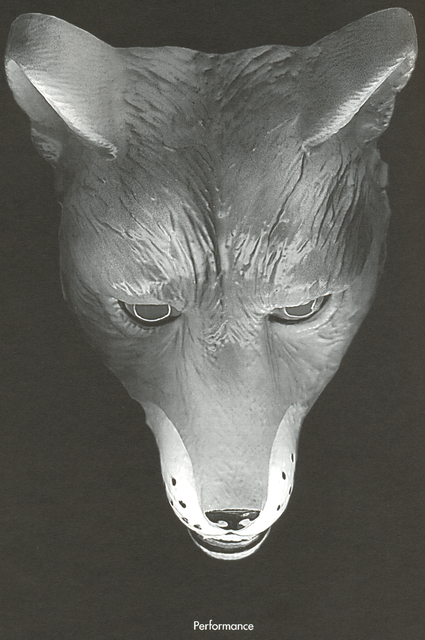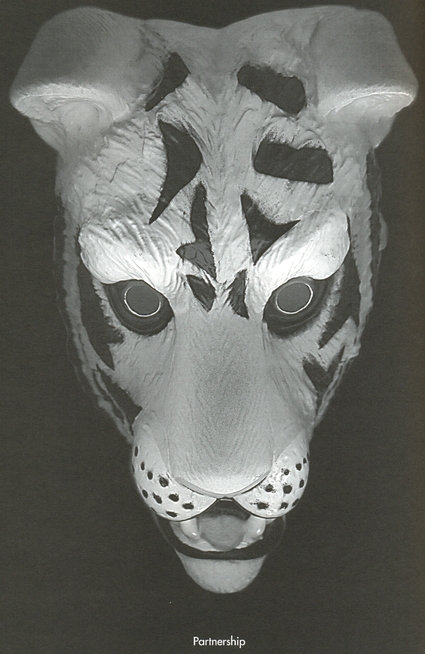Paul Perry - A Bold Proposal - published in Mediamatic Magazine Vol. 7#3/4
The commission was unusual. Fezi Khaleghi Yazdi, initiator of the idea and one of the two directors of Triple P, wanted an artwork that could do more than just decorate his company's walls. He needed an artwork that would be a stimulus and focal point for his people, a work of art to function as a corporate flagship. His expectations of art were high and considerably different from that of most corporate executives.
Triple P itself was unusual. In the Information Technology market the company had expanded enormously over the past years and was succeeding where other automation firms were failing. As a matter of fact, virtually all of Triple P's growth was due to take-overs of failing companies. Through adept management Triple P was able to absorb these companies and turn them around - but it paid a hidden price. For as the company grew, its internal communications - especially communications between its newly acquired daughters - suffered. Rival organizations found themselves partners in name but still rivals in the field. In the process of re-organizational belt tightening, managers were expected to meet their targets. For them, the market was dog eat dog.
Externally, Triple P suffered from another kind of identity problem. No one knew who they were. Most of its customers were still dealing with the trade names of Triple P's various take-overs. This meant that Triple P was not attracting new business on the basis of its own name and reputation. It felt that its management ideology, People, Performance, Partnership needed advertising. Triple P needed an identity and Khaleghi Yazdi sought for a solution in art.
My approach to the assignment was to explore the idea of identity itself. The method I used was to map a series of discourses - on the body, on ecosystems, predator/prey relationships, the behavior of immune systems and notions of autonomy - one on top of the other. The resulting proposal A Bold Proposal and A Modest Proposal (Landscape Automaton) was chaotic and, as the title indicates, actually consisted of two proposals. A Modest Proposal was a plan for a concrete work which involved live turtles with sailing ships stuck to their backs. It was quickly forgotten. A Bold Proposal, not a description of an artwork at all, but a critique of Triple P's approach, was - to my surprise - accepted.
Looking back at A Bold Proposal a year after I wrote it, I see it has many flaws. While my thinking has not changed in respect to network technology, it has developed considerably in the issues of corporate identity. In my analysis I find that I confuse the need for an identity with the need for an ideal and show a rather embarrassing tendency towards moralization. However, in spite of its flaws, it was A Bold Proposal that launched both Triple P and myself in a search for new models and with that in mind, I think it deserves to be presented here.
A Bold Proposal
Uncovering the Corporate Body
God as biologist - pirate - artist: configuring the body as an organ of creation.
Let's assume for a moment that (1) God existed and (2) was cast in the form of a young, energetic, Costa Rican taxonomist with an interest in organizational analysis and (3) on a field trip she came across the previously undocumented Triple P Group. How would she classify it?
Would God view Triple P as a collection of individual agents or a single organized body? A society of 700 individuals commissioned to spend 40 hours a week employed together or a continuous, stand-alone life-form, truly incorporate, roaming around a market? Would God see Triple P as a static system, with its inner elements delicately balanced, or as evolving population, creating and responding to internal and external changes? Would God see an ideology or a culture? An organism or an environment? Opening her notebook, would she draw Triple P as an organizational chart shaped like a pyramid or as a food chain of creatures arranged like a totem pole? What would be the chances of her laying out Triple P as an ecosystem, connecting elements together in lines, a network of causes and effects…
''
Up till now, the main concern of my Public Art work always seems to involve issues of identity. Whenever I am invited for a project I want to know who the commissioners are, and what their interest is in an artwork. And the questions don't stop. I refuse to believe the answers I'm given. How can you make an artwork for a party without questioning the basis of their self-image?''
In most cases the business world views the corporate artwork as an object reflecting the company's image or purely as an object of prestige, reflecting the company's 'cultural interest and responsibility'. Triple P's situation is different.
In Triple P's case, the corporate configuration is too new to have an image. Though Triple P Management has developed a reputation amongst its competitors for its aggressive take-overs and success in the face of bad odds, for the Triple P Group as a whole, a corporate identity is still to be realized.
The importance of developing an image or identity has been recognized by Triple P's management. A strong identity is useful as a binding factor, providing a base for co-operation between individual interests and a sense of continuity and direction for the corporate community as a whole. Corporate identity, like the identity of an individual, develops and grows over time, following a course partly determined by external encounters. Identity is inevitable but unfortunately the process is slow and the outcome unsure. History has shown that in times of need the process can be falsified - histories and ideologies may be invented and an identity adopted - but usually only for a short period of time and with disastrous consequences to the integrity of the individual.
Triple P is looking for an artwork to help define its identity. The brief of the project calls not only for an artwork, but for a concept to serve as a foundation for the company's total image: from a new logo and graphic house style to the interior design of its head office in Driebergen. The artwork is to function as a figurehead for all its activities, to consolidate company forces by way of identification, to embody the corporate spirit and provide a rallying point for corporate pride.
What is the nature of the Triple P body? What does it consume? What are its wastes? How does it reproduce? How does it survive? Could an examination of the role of Triple P within the market place provide insights into its nature? Could an analysis of Triple P as an Information Technology developer uncover previously hidden relationships? What would a close scrutiny of its name: People, Performance, Partnership reveal when held under the magnifying glass? What would come to light if Triple P's ideology was assessed on the basis of its evolutionary fitness?
''
Survival of the Fittest is a very powerful concept when considered as an organizing principle of identity. Fitness refers to either material survival: the survival of a gene, a cell, an organism, or automobile, or conceptual survival'': the survival of an idea, a personality, a culture, a set of laws, or a company. As a basic principle of life it is observable everywhere, throughout our hierarchy of structures, from simple to complex, from interpersonal to international.
The first words of admonition in Sun Tzu's 2000 year old book on strategy, The Art of War draws our attention to the necessity of looking at conflict and its result, survival or death, as a process integral to life itself:
Military action is important to the nation - it is the ground of death and life, the path of survival and destruction, so it is imperative to examine it.
Survival is determined by an individuals success or failure in relation to its environment. However, determining the boundaries of the individual may not be easy. For the survival of an idea may mean the death of many brain cells. And the survival of a market might mean the end of a few businesses.
Sun Tzu's nation could describe any level of organization - it could refer to the cell, the individual, the workgroup, the department, or the company. For both Sun Tzu and our taxonomist God, it is the appreciation of this force and the anticipation of conflict that is the organizing principle that provides clues to the identity of the corporate body. In other words: it is not the conflict that is important, but awareness of the potential for conflict that determines the constitution of the body, the city or the state. Identity is a form of preparation.
Paul Perry - A Bold Proposal - published in Mediamatic Magazine Vol. 7#3/4
Predator/Prey
But let us change our viewpoint and assume that God is a criminal, a pirate dedicated to liberty and self-determination, and Triple P is a superorganism, housed in a single body. This point of view emphasizes Triple P's external rather than internal relations and forces a more political choice upon our analyst/God. If (1) God existed, and (2) was a pirate, how would he respond if Triple P sailed on to his horizon?
Would God view Triple P as friend or foe?
At the outset of the commission I was surprised to learn that Triple P appeared to be only minimally utilizing the information and network technology that it develops and sells. Why is that? Information Technology, in its current state, is the most powerful medium for political, social and economic change that mankind has yet created. For the implementation of networks and network thinking represent not only a radical break with the traditional hierarchical command and control structures found in the business world, but a revolution in worlds as seemingly diverse as politics, education, resource management, entertainment and health care.
As Lawrence Tesler, vice-president for advanced projects for Apple Computer put it:
The networked computer will challenge not only business but society itself.
That a shift has been made can be seen in virtually every discipline. The last decade has seen a widening of academic focus, moving from the node, or the isolated cognitive/computer paradigm to the distributed network paradigm and the study of a network's emergent properties. With emergence we mean the appearance of those novel properties in whole systems which cannot be explained by the behavior of the individual elements of those systems. When enough nodes are connected and communicating surprising things happen.
Networks are found everywhere in nature, from lan's and wan's to ecosystems and the processes of mind and consciousness. The study of networks provides keys to understanding the patterns of complex, non-linear behavior, and as such is useful in predicting outcomes - from encounters in dark alleys, to trends in global economies. In the world of high technology, networks are seen as radical new media, extensions of man that can fundamentally change the way the human being lives and works. The anti-hierarchical nature of the network and the ability to interact in a meaningful manner with others without having to share a neighboring space or time with them will ultimately disrupt the entire realm of politics and social geography, marking the end of the notion of physically co-located communities and, eventually, the large scale industrial/military complexes known as countries.
So what exactly is Triple P up to? What does is it mean to be a trader in Information Technology? A predator in the economy of information?
In our western culture, information and knowledge have become our primary commodity. We manufacture our wealth from knowledge. Those who use and control information and information technology wield considerable power. This new mine of wealth has not escaped the attention of the already powerful, who sow fear of the competition in a bid to remain in control.
We cannot afford to remain deadlocked. The alternative is to wait until other nations show us how to take advantage of this (network/information) technology - and they will. We must move first.
(Al Gore, Scientific American, September 1991)
The geosphere - once the ground of life and death, where the physical struggle for material resources and the control of space was negotiated - is giving way to the virtual realm of information, the infosphere, as the new territorial prize.
Network technology empowers the information user like weapon technology empowered the old territorial politicians. The good news is that the power is distributed and tends to collect at the grass roots level rather than at the top. Information power increases as it rises, as users connect and process each other's information. The bottom up structure is able to resist attempts at centralizing control.
The ultimate nature of information and network technology is subversive, anti-hierarchical, anti-organizational chart, anti-bureaucracy, anti-government. It would also appear that those who invest in information and network technology hold the keys to the future. So why does Triple P only sell the weapons and not make use of the technology itself? In a market of producers and consumers - who is predator and who is prey? The pirates of the 18th century were renowned for both their anti-authoritarian stance and their establishment of an alternative economy and information network free of the European government's policies of containment and exploitation.
How would God as pirate look at Triple P?
The Autonomous Body
The immunologist, Francisco Varela has described the autonomous system as a system whose fundamental organization corresponds to what he calls operational closure.
Operational closure is a form of fully self-referential network constitution that specifies its own identity; but also specifies the way in which it comes to terms with whatever comes its way. That is, it establishes a sense of copulative world around it.
(Francisco Varela, Gaia 2, New York 1991)
Identity according to Varela means not only a sense of personal autonomy but also a particular etiquette, a pattern of behavior towards what the body meets on its horizon. World view and corporate self-image are intertwined with each other. Alterations in corporate self-image (identity) lead to alterations in world view (horizon) and vice versa. The agents of the network stimulate each other and evolve.
Okay, let's look at Triple P one last time and pretend that (1) God exists, and (2) was an artist who (3) was able to erase all corporate history up to the present moment and (4) was able to invent a bold new identity for the corporate body. What sort of identity would she provide?
The answer is none. According to our theory of identity such an act of God is impossible. Identity cannot be given. Although we can fabricate history and distort the environment, identity is not something that can be created. God herself, could not perform this sort of miracle.
Identity is not an object; it is a process with addresses for all the different directions and dimensions in which it moves…
(Lynn Margulis, Gaia 2, New York 1991)
Paul Perry - A Bold Proposal - published in Mediamatic Magazine Vol. 7#3/4
How can we arrive at an appropriate proposal for an artwork of identity if the identity of Triple P is emergent, that is, self-specified and relying upon a network of relations rather than an association with a particular object or idea? Perhaps we should imagine the artwork itself as being an autonomous, copulative system, a body sharing the same market as Triple P. To this end I have chosen the following guidelines in an attempt to govern the artworks behavior:
1. If the artwork should utilize the products of technology it should not rely on the speed and the scope of those technological products, for each day's state of the art is antiquated at the end of the day.
2. If the artwork should utilize the products of technology it would be better if the work was constructed in a modular manner, with components that were upgradable, and allowed/required additions over time.
3. The artwork should be allowed to develop in an organic fashion. A network, for example, grows and develops at its own pace, according to its inner laws and interactions. The artwork should be encouraged to grow, interact with, be shaped by, learn from, and eventually exploit, its habitat.
4. Ideally the artwork should be distributed, both materially and conceptually. The artwork should not be concentrated in any particular place.
5. The artwork should illustrate and elaborate upon the principles of autonomy.
6. The artwork should be autonomous but not isolated. External events should be permitted to cross the boundary of the work and be either incorporated as changes in the work or force the work to perish. Likewise the artwork should exert influence on its environment to the point of changing it.
7. The artwork should not be considered as a commodity but as a medium for corporate feedback.
Following these guidelines, I'll make a proposal:
The Bold Proposal
A: The artist will work with the corporation on a contract basis for a number of years.
B: The artist will develop within the corporation an internal network focused on the contingencies of Triple P's continued success.
C: The artist will provoke corporate experience by investigating technological concepts such as: the corporation without employees, the identity of virtual communities, collaborative work in virtual markets, object exchange and super-distribution, the development of digital reputations etc.
D: The artist will together with the corporation develop the results of these provocations into further provocations.
Paul Perry, december 1992